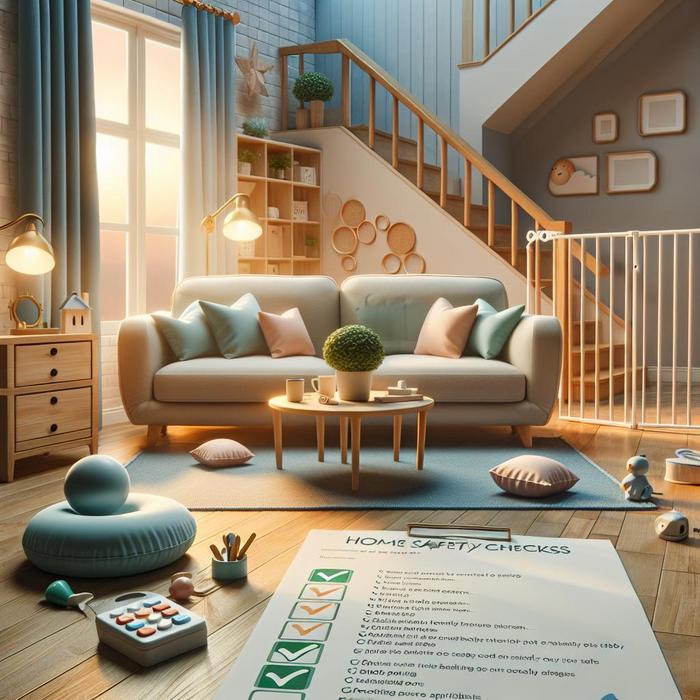Our Comprehensive Safety Checklist for Parents
Ensuring your home environment is safe for your baby is absolutely pivotal. Children are naturally curious, and this curiosity often leads them into corners of the home that parents might not consider as potential danger zones. This is why it’s crucial to put a comprehensive safety checklist for parents into action. Below are some of the precautions we regularly perform in our home.
1. Conduct Regular Home Safety Inspections
Regular home safety inspections are the first step in our safety checklist for parents. By checking every corner of the home, we ensure that potential hazards are identified and mitigated promptly. This includes checking the stability of furniture, ensuring electrical outlets are covered, and securing window guards.
2. Implement Baby-Proofing Measures
Baby-proofing is an ongoing process, and for us, it forms a critical part of our safety checklist. We pay special attention to:
- Stair gates: We have installed safety gates at both the top and bottom of our stairs to prevent tumbles.
- Cabinet locks: We use safety locks on cabinets containing chemicals or potential choking hazards.
- Corners and edges: We’ve padded sharp corners and edges to prevent accidental bumps and bruises.
- Securing furniture: We have secured heavy furniture to the wall to prevent them from tipping over.
3. Encourage Safe Play
Safe play is essential in preventing accidents. We follow the guidelines provided by Biomimetic Feeding to foster activities that not only encourage our baby’s physical development but are also safe.
4. Equip Our Home with Safety Devices
As part of our safety checklist for parents, we have installed various safety devices in our home. These include:
- Smoke detectors: We have installed these throughout our home and regularly check their functionality.
- Carbon monoxide detectors: These important devices are placed near bedrooms and on every level of our house.
- Fire extinguishers: We keep fire extinguishers in key locations, including the kitchen and garage.
- Baby monitors: These keep us alerted to any noises our baby makes while they are sleeping or playing in another room.
Though it may seem like a daunting task, implementing a safety checklist for parents is an essential step in ensuring your home is a safe and nurturing environment for your child. Continually reassessing potential risks and taking the necessary steps to mitigate them makes for a safer and happier home. Remember, baby-proofing and preventing accidents are ongoing processes, not one-time tasks.
5. Regular Professional Home Safety Inspections
While our routine safety inspections are the first line of defence, we take our responsibility a step further by arranging regular professional home safety checks, such as those suggested by the Arlington Fire Department and the Department of Housing and Urban Development. Professional inspectors cover areas that we might miss, ensuring that every corner of our home is safe.
6. Training to Handle Emergencies
As parents, we understand that it’s crucial to be prepared for emergencies. We have undergone various training programs to equip us with the necessary knowledge and skills to handle unpredictable situations. These include first-aid and cardiopulmonary resuscitation training, fire safety training, and more.
7. Inclusion of Danger Zones in Safety Checklists
Some zones in the house start to pose a danger as children begin to crawl or walk. Our comprehensive safety checklist contains an extensive inspection of such areas, including:
- The bathroom: We’ve installed non-slip mats to prevent slipping and falling, and we always keep medications and cleaning supplies out of reach.
- The kitchen: With numerous potentially hazardous objects, we’ve made sure all sharp utensils, hot pans, and dangerous appliances are out of reach.
- The garage and basement: These spots often contain dangerous tools and chemicals. We keep them securely locked and out of our child’s reach.
8. Periodic Reviews and Updates to Safety Measures
We consider baby-proofing and safety to be dynamic processes that need regular review and updates. As our child grows, so do their abilities. What was safe yesterday may not be safe today. Therefore, we regularly consult with experts, visit trusted websites like Arkansas Government’s Health Department, and stay updated on various child safety measures.
9. Networking with Other Parents for Safety Tips
Sharing experiences and tips with other parents is a valuable resource we regularly utilize. Parenting forums and social media groups prove to be reservoirs of real-life experiences, tips, and advice.
10. Educating Our Child About Safety
Once our child is old enough to understand basic safety rules, we will start educating them. Whether it’s the danger of hot objects, the importance of staying away from sockets, or not running on slippery floors, we believe in educating our child about basic safety measures at an early age.
We hope our comprehensive safety checklist for parents serves as a useful reference. Remember, the safety of your child is an ongoing commitment that requires vigilance and constant updates. By prioritizing safety, you ensure your home is not just a shelter, but a safe haven for your child.

